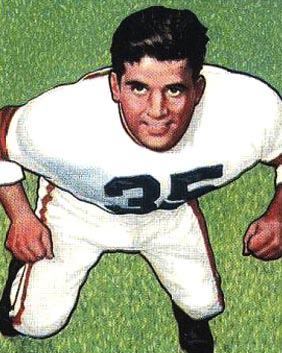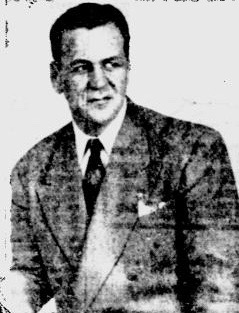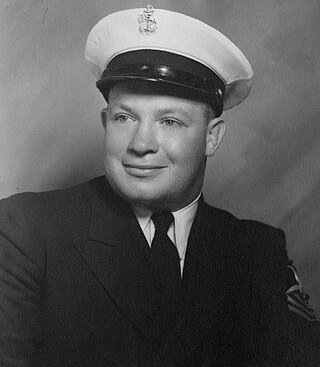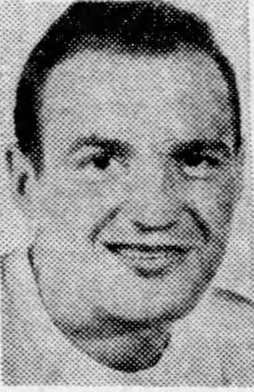Related Research Articles

Elroy Leon "Crazylegs" Hirsch was an American professional football player, sport executive and actor. He was inducted into the Pro Football Hall of Fame in 1967 and the College Football Hall of Fame in 1974. He was also named to the all-time All-Pro team selected in 1968 and to the National Football League (NFL) 1950s All-Decade Team.

August Michael Michalske, sometimes known as "Iron Mike", was an American football player and coach. He was inducted into the Pro Football Hall of Fame as part of its second induction class in 1964. He was also named in 1969 to the NFL 1920s All-Decade Team.

Alexander Arrasi Agase was an American football guard and linebacker who was named an All-American three times in college and played on three Cleveland Browns championship teams before becoming head football coach at Northwestern University and Purdue University.

Frank Manning "Bruiser" Kinard Sr. was an American football tackle and coach and university athletic administrator. He was inducted into the College Football Hall of Fame as a charter member in 1951 and into the Pro Football Hall of Fame in 1971.

Edward Patrick "Slip" Madigan was an American football player and coach of football, basketball, and baseball. He served as the head coach at Saint Mary's College of California from 1921 to 1939 and at the University of Iowa from 1943 to 1944, compiling a career college football record of 119–58–13. Madigan was also the head basketball coach at Saint Mary's from 1921 to 1927 and the head baseball coach at the school from 1926 to 1930. He played football at the University of Notre Dame as a center. Madigan was inducted into the College Football Hall of Fame as a coach in 1974.

Edward Nicholas Anderson was an American football player and coach of football and basketball. He served as the head football coach at Columbia College in Dubuque, Iowa, now known as Loras College (1922–1924), DePaul University (1925–1931), the College of the Holy Cross, and the University of Iowa, compiling a career college football record of 201–128–15. Anderson was also the head basketball coach at DePaul from 1925 to 1929, tallying a mark of 25–21 Anderson played professional football in the National Football League (NFL) for the Rochester Jeffersons in 1922 and the Chicago Cardinals from 1922 to 1925. He was inducted into the College Football Hall of Fame as a coach in 1971.

Robert James "Hunchy" Hoernschemeyer was an American football player. A native of Cincinnati, he played college football as a halfback for the Indiana Hoosiers football in 1943 and 1944 and as a quarterback for the Navy Midshipmen football team in 1945. He led the NCAA in both total offense and passing yards during the 1943 season.

William Franklin Conkright, known more commonly by the nickname "Red", was an American football center and end who played eight seasons in the National Football League (NFL) and was later the head coach of the Oakland Raiders for part of the 1962 season.

Stephen Patrick Sinko was an American football player and coach. He played professionally as a guard and tackle in the National Football League (NFL) for the Boston Redskins from 1934 to 1936 and the Los Angeles Bulldogs from 1937 to 1938. Sinko served as the head football coach at Boston University from 1957 to 1963, compiling a record of 23–36–3.
The 1946 Chicago Rockets season was the inaugural season for both the Chicago Rockets and the All-America Football Conference (AAFC) in which they played. The Rockets compiled a 5-6-3 record, were outscored by a total of 315 to 263, and finished in last place in the AAFC's West Division.
Robert J. Derleth was an American football lineman. He played college football for the University of Michigan Wolverines football teams in 1942, 1943, 1945 and 1946 — missing the 1944 season due to military service. He also played professional football for the Detroit Lions in 1947.

The 1946 Michigan Wolverines football team represented the University of Michigan in the 1946 Big Nine Conference football season. In their ninth year under head coach was Fritz Crisler, the Wolverines compiled a 6–2–1 record, outscored opponents 233 to 73, and finished the season in second place in the Big Nine Conference and ranked No. 6 in the final 1946 AP poll. The team's two losses came against an undefeated Army team that was ranked No. 2 in the final AP poll and against an Illinois team that won the Big Nine championship and was ranked No. 5 in the final AP poll. Michigan won its last four games by a combined score of 162 to 19, starting a 25-game winning streak that continued for nearly three years until October 8, 1949. In the final game of the 1946 season, Michigan defeated Ohio State, 58–6, the Buckeyes' worst defeat since joining the conference in 1913.

Frederick Owen "Dippy" Evans Jr. was a professional American football halfback who played for three years in the All-America Football Conference (AAFC) and the National Football League (NFL) in the late 1940s.

William Harold Lund was a professional American football halfback who played two seasons for the Cleveland Browns in the All-America Football Conference (AAFC).

Roman John "Ray" Piskor was an American football tackle who played three seasons in the All-America Football Conference (AAFC) between 1946 and 1948. Piskor played for the New York Yankees, Cleveland Browns and the Chicago Rockets. Piskor grew up in North Tonawanda, New York and attended Niagara University, where he was a star lineman. After several years in the Army Air Force during World War II, he was signed by the Yankees in 1946. Piskor was traded to the Browns the following year, when the team won the AAFC championship. He spent a final season with the Rockets in 1948.

Leonard Bernard "Butch / Len" Levy was an American football player, amateur wrestler, and professional wrestler. The 1941 NCAA heavyweight wrestling champion and 1942 AAU champion, he was selected by the Cleveland Rams of the National Football League (NFL) in the fourth round of the 1942 NFL Draft. He instead enlisted in the United States Navy and played for one of that branch's organized military service teams, the Great Lakes Bluejackets.
The Million Dollar Backfield was a National Football League (NFL) offensive backfield of the Chicago Cardinals in 1947 after an unprecedented amount of money by Cardinals owner Charles Bidwill lured several of the day's top players to the team. The Million Dollar backfield was also referred to separately as the Dream Backfield by Bidwill.
The 1946 AAFC season was the first season of the All-America Football Conference, a new professional league established to challenge the market dominance of the established National Football League. The league included eight teams, broken up into Eastern and Western divisions, which played a 14-game official schedule, culminating in a league championship game.

Robert Peter Jensen was an American football end.

Bruno Joseph Niedziela was an American football tackle who played one season in the All-America Football Conference (AAFC) for the Chicago Rockets. He played college football for Iowa.
References
- ↑ "Pat Boland Record, Statistics, and Category Ranks". Pro-Football-Reference.com.
- ↑ "Pat Boland Named Rockets Coach". The Honolulu Advertiser. October 30, 1946. p. 16 – via newspapers.com.
- 1 2 "Patrick Roland (published 1971)". New York Times. July 3, 1971 – via NYTimes.com.